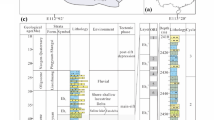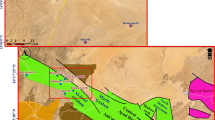Abstract
Following shale gas, shale oil has become another highlight in unconventional hydrocarbon exploration and development. A large amount of shale oil has been produced from a host of marine shale in North America in recent years. In China, lacustrine shale, as the main source rock of conventional oil and gas, should also have abundant oil retained in place. In this study, geochemical and geologic characteristics of lacustrine shale from Es3 L sub-member in Bonan sag were characterized by using total organic carbon (TOC), Rock-Eval pyrolysis, X-ray diffraction, and Δlog R method. The results show that the Es3 L sub-member shale have TOC contents ranging from 0.5 wt.% to 9.3 wt.%, with an average of 2.9 wt.%. The organic matter is predominantly Type I kerogen, with minor amounts of Type II1 kerogen. The temperature of maximum yield of pyrolysate (T max) values ranges from 424 to 447 °C, with an average of 440 °C, and vitrinite reflectance (Ro%) ranges from 0.7% to 0.9%, indicating most of shales are thermally mature. The dominant minerals of Es3 L shale in Bonan sag are carbonates (including calcite and dolomite), averaging 51.82 wt.%, and the second minerals are clay (mostly are montmorillonite-illite-mixed layer and illite) and quartz, averaging about 18 wt.%. Finally, its shale oil resources were evaluated by using the volumetric method, and the evaluation result shows that the shale oil resource is up to 5.94 billion tons, and mostly Class I resource. Therefore, the exploration of the lacustrine shale oil of Es3 L in Bonan sag should be strengthened.
Similar content being viewed by others
References
Badics, B., Vetö, I., 2012. Source Rocks and Petroleum Systems in the Hungarian Part of the Pannonian Basin: The Potential for Shale Gas and Shale Oil Plays. Marine and Petroleum Geology, 31(1): 53–69. https://doi.org/10.1016/j.marpetgeo.2011.08.015
Bowker, K. A., 2007. Barnett Shale Gas Production, Fort Worth Basin: Issues and Discussion. AAPG Bulletin, 91(4): 523–533. https://doi.org/10.1306/06190606018
Chen, H., 2006. Fractured Shale Gas Exploration Status. Foreign Science and Technology Information, 2006: 4–19 (in Chinese)
Clarkson, C. R., Solano, N., Bustin, R. M., et al., 2013. Pore Structure Characterization of North American Shale Gas Reservoirs Using USANS/ SANS, Gas Adsorption, and Mercury Intrusion. Fuel, 103(1): 606–616. https://doi.org/10.1016/j.fuel.2012.06.119
Coope, D. F., Quinn, T. H., Frost, E., et al., 2009. A Rock Model for Shale Gas and Its Application Using Magnetic Resonance and Conventional LWD Logs. Society of Petrophysicists and Well-Log Analysts, 50th Annua Symposium, Texas
Dong, D., Yang, S. B., Xiang, X. Y., et al., 1993. Muddy Hydrocarbon Reservoirs in Jiyang Depression. Petroleum Exploration and Development, 20(6): 15–22 (in Chinese with English Abstract)
Durand, B., Alpern, B., Pittion, J. L., et al., 1986. Reflectance of Vitrinite as a Control of Thermal History of Sediments. In: Burrus, J., ed., Thermal Modeling in Sedimentary Basins, Editions Technip, Paris. 441–474
Horsfield, B., Schulz, H. M., 2012. Shale Gas Exploration and Exploitation. Marine and Petroleum Geology, 31(1): 1–2. https://doi.org/10.1016/j.marpetgeo.2011.12.006
Jarvie, D. M., Hill, R. J., Ruble, T. E., et al., 2007. Unconventional Shale-Gas Systems: The Mississippian Barnett Shale of North-Central Texas as One Model for Thermogenic Shale-Gas Assessment. AAPG Bulletin, 91(4): 475–499. https://doi.org/10.1306/12190606068
Jarvie, D. M., 2012. Shale Resource Systems for Oil and Gas: Part 2—Shale-Oil Resource Systems, In: Breyer, J. A., ed., Shale Reservoirs—Giant Resources for the 21st Century. AAPG Memoir, 97: 89–119
Jiu, K., Ding, W. L., Huang, W. H., et al., 2013. Fractures of Lacustrine Shale Reservoirs, the Zhanhua Depression in the Bohai Bay Basin, Eastern China. Marine and Petroleum Geology, 48(12): 113–123. https://doi.org/10.1016/j.marpetgeo.2013.08.009
Kirschbaum, M. A., Mercier, T. J., 2013. Controls on the Deposition and Preservation of the Cretaceous Mowry Shale and Frontier Formation and Equivalents, Rocky Mountain Region, Colorado, Utah, and Wyoming. AAPG Bulletin, 97(6): 899–921. https://doi.org/10.1306/10011212090
Kinley, T. J., Cook, L. W., Breyer, J. A., et al., 2008. Hydrocarbon Potential of the Barnett Shale (Mississippian), Delaware Basin, West Texas and Southeastern New Mexico. AAPG Bulletin, 92(8): 967–991. https://doi.org/10.1306/03240807121
Liu, C., Lu, S. F., Huang, W. B., et al., 2011. Improvement of Δlog R and Its Application in Source Rocks Evaluation. Petroleum Geology and Oilfield Development in Daqing, 30(3): 27–31 (in Chinese with English Abstract)
Li, Z. M., Qin, J. Z., Xu, X. H., et al., 2008. The Relationship between Vitrinite Reflectance Suppression and Source Rock Quality—A Case Study on Source Rocks from the Dongying Sag, Bohai Bay Basin. Petroleum Geology & Experiment, 30(3): 276–280 (in Chinese with English Abstract)
Lin, S. H., Yuan, X. J., Tao, S. Z., et al., 2013. Geochemical Characteristics of the Source Rocks in Mesozoic Yanchang Formation, Central Ordos Basin. Journal of Earth Science, 24(5): 804–814. https://doi.org/10.1007/s12583-013-0379-1
Lu, S. F., Huang, W. B., Chen, F. W., et al., 2012. Classification and Evaluation Criteria of Shale Oil and Gas Resources: Discussion and Application. Petroleum Exploration and Development, 39(2): 268–276. https://doi.org/10.1016/s1876-3804(12)60042-1
Ning, F. X., 2008. Mechanism of Mudstone Fracture Reservoir Forming in Xianhezhuang Oilfield in Dongying Depression. Xinjiang Oil & Gas, 4(1): 20–25 (in Chinese with English Abstract)
Pan, S. Q., Zou, C. N., Yang, Z., et al., 2015. Methods for Shale Gas Play Assessment: A Comparison between Silurian Longmaxi Shale and Mississippian Barnett Shale. Journal of Earth Science, 26(2): 285–294. https://doi.org/10.1007/s12583-015-0524-0
Passey, Q. R., Creaney, S., Kulla, J. B., et al., 1990. A Practical Model for Organic Richness from Porosity and Resistivity Logs. AAPG Bulletin, 74(12): 1777–1794
Passey, Q. R., Bohacs, K., Esch, W. L., et al., 2010. From Oil-Prone Source Rock to Gas-Producing Shale Reservoir—Geologic and Petrophysical Characterization of Unconventional Shale Gas Reservoirs. International Oil and Gas Conference and Exhibition in China, Beijing. https://doi.org/10.2118/131350-ms
Ross, D. J. K., Bustin, R. M., 2008. Characterizing the Shale Gas Resource Potential of Devonian-Mississippian Strata in the Western Canada Sedimentary Basin: Application of an Integrated Formation Evaluation. AAPG Bulletin, 92(1): 87–125. https://doi.org/10.1306/09040707048
Shi, D. S., Li, M. W., Pang, X. Q., et al., 2005. Fault-Fracture Mesh Petroleum Plays in the Zhanhua Depression, Bohai Bay Basin: Part 2. Oil-Source Correlation and Secondary Migration Mechanisms. Organic Geochemistry, 36(2): 203–223. https://doi.org/10.1016/j.orggeochem.2004.09.003
Slatt, R. M., Rodriguez, N. D., 2012. Comparative Sequence Stratigraphy and Organic Geochemistry of Gas Shales: Commonality or Coincidence? Journal of Natural Gas Science and Engineering, 8(8): 68–84. https://doi.org/10.1016/j.jngse.2012.01.008
Song, M. Y., 2011. Study on Reservoir Development and Forming Mechanism of Fractured Shale Reservoirs in Bonan Sub-Sag: [Dissertation]. China University of Petroleum, Dongying (in Chinese with English Abstract)
Wang, G. L., Wang, T. G., Simoneit, B. R. T., et al., 2010. Sulfur Rich Petroleum Derived from Lacustrine Carbonate Source Rocks in Bohai Bay Basin, East China. Organic Geochemistry, 41(4): 340–354. https://doi.org/10.1016/j.orggeochem.2009.12.010
Wang, G. C., Carr, T. R., 2013. Organic-Rich Marcellus Shale Lithofacies Modeling and Distribution Pattern Analysis in the Appalachian Basin. AAPG Bulletin, 97(12): 2173–2205. https://doi.org/10.1306/05141312135
Wang, M., Tian, S. S., Chen, G. H., et al., 2014. Correction Method of Light Hydrocarbons Losing and Heavy Hydrocarbon Handling for Residual Hydrocarbon (S1) from Shale. Acta Geologica Sinica—English Edition, 88(6): 1792–1797. https://doi.org/10.1111/1755-6724.12345
Wang, M., Wilkins, R. W. T., Song, G. Q., et al., 2015. Geochemical and Geological Characteristics of the Es3 L Lacustrine Shale in the Bonan Sag, Bohai Bay Basin, China. International Journal of Coal Geology, 138(1): 16–29. https://doi.org/10.1016/j.coal.2014.12.007
Witkowsky, J. M., Galford, J. E., Quirein, J. A., et al., 2012. Predicting Pyrite and Total Organic Carbon from Well Logs for Enhancing Shale Reservoir Interpretation. SPE Eastern Regional Meeting, Lexington KY. https://doi.org/10.2118/161097-ms
Zhang, L. Y., Li, Z., Zhu, R. F., 2008. Resource Potential of Shale Gas in Paleogene in Jiyang Depression. Natural Gas Industry, 28(12): 26–29 (in Chinese with English Abstract)
Zhang, J. C., Lin, L. M., Li, Y. X., et al., 2012. Classification and Evaluation of Shale Oil. Earth Science Frontiers, 19(5): 322–331 (in Chinese with English Abstract)
Zhang, L. Y., Li, Z., Li, J. Y., et al., 2012. Feasibility Analysis of Existing Recoverable Oil and Gas Resource in the Palaeogene Shale of Dongying Depression. Natural Gas Geosciences, 23(1): 1–13 (in Chinese with English Abstract)
Zhang, S. W., Wang, Y. S., Zhang, L. H., et al., 2012. Formation Conditions of Shale Oil and Gas in Bonan Sub-Sag, Jiyang Depression. China Engineering Science, 14(6): 49–55 (in Chinese with English Abstract)
Zhang, L. Y., Li, J. Y., Li, Z., et al., 2014. Advances in Shale Oil/Gas Research in North America and Considerations on Exploration for Continental Shale Oil/Gas in China. Advances in Earth Science, 29(6): 700–711 (in Chinese with English Abstract)
Zhao, W. Z., Zhang, G. Y., Wang, H. J., 2003. Basic Features of Petroleum Geology in the Superimposed Petroliferous Basins of China and Their Research Methodologies. Petroleum Exploration and Development, 30(2): 1–6 (in Chinese with English Abstract)
Zhu, G. Y., Gu, L. J., Su, J., et al., 2012. Sedimentary Association of Alternated Mudstones and Tight Sandstones in China’s Oil and Gas Bearing Basins and Its Natural Gas Accumulation. Journal of Asian Earth Sciences, 50(5): 88–104. https://doi.org/10.1016/j.jseaes.2012.01.008
Zou, C. N., Dong, D. Z., Wang, S. J., et al., 2010. Geological Characteristics and Resource Potential of Shale Gas in China. Petroleum Exploration and Development, 37(6): 641–653. https://doi.org/10.1016/s1876-3804(11)60001-3
Zou, C. N., Yang, Z., Cui, J. W., et al., 2013a. Formation Mechanism, Geological Characteristics and Development Strategy of Nonmarine Shale Oil in China. Petroleum Exploration and Development, 40(1): 15–27. https://doi.org/10.1016/s1876-3804(13)60002-6
Zou, C. N., Tao, S. Z., Yang, Z., et al., 2013b. Development of Petroleum Geology in China: Discussion on Continuous Petroleum Accumulation. Journal of Earth Science, 24(5): 796–803. https://doi.org/10.1007/s12583-013-0373-7
Acknowledgements
We would like to thank anonymous reviewers for constructive comments. This study was supported by the National Natural Science Foundation of China (Nos. 41672116, 41330313), the Fundamental Research Funds for the Central Universities (No. 17CX05012) and National Science and Technology Major Project of China (Nos. 2017ZX05049004, 2016ZX05046-001). The final publication is available at Springer via https://doi.org/10.1007/s12583-016-0945-4.
Author information
Authors and Affiliations
Corresponding author
Rights and permissions
About this article
Cite this article
Lu, S., Liu, W., Wang, M. et al. Lacustrine shale oil resource potential of Es L3 Sub-Member of Bonan Sag, Bohai Bay Basin, Eastern China. J. Earth Sci. 28, 996–1005 (2017). https://doi.org/10.1007/s12583-016-0945-4
Received:
Accepted:
Published:
Issue Date:
DOI: https://doi.org/10.1007/s12583-016-0945-4




